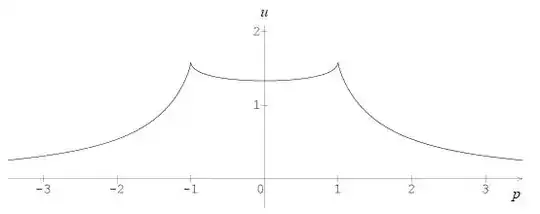In a recent StackOverflow question, I came across this formula:
$$up = (1 + p)^\frac{2}3 - (1 - p)^\frac{2}3 $$
and the question required the poster to plot p as a function of u. I misunderstood the question and thought it was just a simple dividing both sides by p.
Upon being corrected, I realized that I had to change the formula such that it would be p=f(u).
I tried the following:
First try:
$$up + (1 - p)^\frac{2}3 = (1 + p)^\frac{2}3$$
Cube both sides:
$$(up + (1 - p)^\frac{2}3)^3 = (1 + p)^2$$
Expanding the left:
$$ (up)^3 + 3(up)^2(1 - p)^\frac{2}3 + 3(up)(1 - p)^\frac{4}3 + (1 - p)^2 = (1 + p)^2$$
At this point, I stopped and realized that if I were to proceed with singling out the cubed roots, I'd get even more terms with cubed roots.
So, 2nd try:
Let $a = (1 + p)^\frac{1}3$ and $b = (1 - p)^\frac{1}3$, so $p = a^3 - 1$ or $p = 1 - b^3$.
So I get: $$u(a^3 - 1) = a^2 - b^2$$
Then:
$$a^2 - u(a^3 - 1) = b^2$$
I'm not even sure this is the right approach as it's just as complicated and doesn't help me.
So I firstly had to understand what it meant to a function having an inverse.
To re-acquaint myself with this simply basic concept (haven't done any 'hard'(very relative) maths in some time), I came across this link)
A function, f(x) has an inverse function if f(x) is one-to-one
The original question is just: $yx = (1 + x)^\frac{2}3 - (1 - x)^\frac{2}3$
So,
$$y = \frac{1}x [(1 + x)^\frac{2}3 - (1 - x)^\frac{2}3]$$
I had thought to prove that this function is one to one (i.e. assume $a \not= b$ and $f(a) = f(b)$ and arrive at a conclusion of RAA) as follows:
Assume a and b are in the domain, and $a \not= b$ but $f(a) = f(b)$.
So
$$\frac{1}a ((1 + a)^\frac{2}3 - (1 - a)^\frac{2}3) = \frac{1}b ((1 + b)^\frac{2}3 - (1 - b)^\frac{2}3)$$
Which after some basic algebraic manipulation:
$$b(1 + a)^\frac{2}3 + a(1 - b)^\frac{2}3 = a(1 + b)^\frac{2}3 + b(1 - a)^\frac{2}3$$
Which seems like a rabbit hole in itself.
At this point, I tried the following code:
def sq(in_v):
return (in_v ** 2) ** (1.0 / 3.0)
def f(x):
retval = 0
if x != 0:
ux = float(x)
retval = (1.0 / ux) * ((sq(1.0 + ux) - sq(1.0 - ux)))
return retval
for i in range(1, 1000):
print(i, f(i))
Which outputted:
(1, 1.5874010519681994)
(2, 0.540041911525952)
(3, 0.31081368260718234)
(4, 0.2109834787902405)
(5, 0.156417029820976)
(6, 0.12254799530168421)
(7, 0.09972467872933903)
(8, 0.08343037511240664)
(9, 0.07128764817919765)
(10, 0.06193387323264759)
(11, 0.05453581407318313)
(12, 0.04855728086918091)
(13, 0.04363868808814697)
(14, 0.039530512992466287)
(15, 0.0360545649539396)
(16, 0.03308043893028406)
(17, 0.030510661614540784)
(18, 0.028271018913558234)
(19, 0.026304081155830626)
(20, 0.024564762605912584)
(21, 0.023017210155186492)
(22, 0.021632581275900904)
(23, 0.020387429637735967)
...
Which seems like the i'th value isn't the same as the (i+1)th value. So I'm guessing there is an inverse function. (This is also assuming I even programmed this correctly).
At this point, it is unclear on how I can proceed to find the inverse function.
My mind's so blank right now, I'm not sure how to proceed or even if I'm just barking up the wrong tree and that I misunderstood the question entirely (of which I apologize).
Can someone please clarify where I went wrong? My lack of maths practice has severely degraded my maths.
I appreciate the help,

